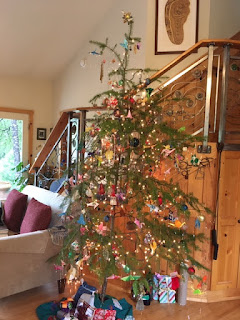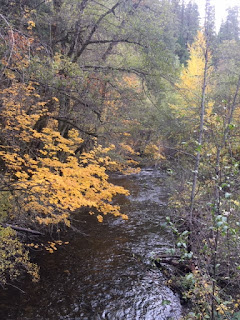It snowed. And then it snowed and snowed and snowed. When it stopped, the earth was white with two feet of snow and the tree limbs bowed low with heavy snow burdens. Then it snowed again, another six inches or more.  |
| The first snowfall, before it got deep |
I was ecstatic.
The electricity went out—no internet, no cell service, no email, no cookstove. The outdoor shower had frozen, but the water was still running, so I could shower indoors, in my beautiful bathroom.
I filled the bathtub with water in case the holding tank emptied. The landline phone had gone dead earlier but was working now. The house would stay warm with my wood-burning stove. I had already driven my car the quarter-mile downhill distance to the paved road. I was comfortably snowed in.
I knew, from experience, that the snowplow would have just about buried the car, which was parked by the side of the road, so I was anxious to dig it out while the snow was still soft, before it froze. So, on the first day of the two-foot snow, I decided that that would be the day's task.
First, though, I should make sure the snow was skiable.
I put my skis on at the back door, then skied down my driveway. My skis sank deep into the soft snow with each step. I didn't want to stop. I skied through the woods to an old logging road, then on up the mountain. It was tough going, breaking trail through such deep snow. I struggled up the mountain till the road flattened, and then I still didn't want to stop. I kept on going, up and up, till finally I came to my senses. The day's task was to dig the car out. I ought to go home.
Even downhill, even in my tracks, I had to push through snow, so it was still slow going. By the time I got home, I had been gone three hours. I ate a hurried lunch, grabbed the car keys, and tied a shovel to my pack, fastening it securely. Then I put on my skis and started down the road, with the shovel sticking two feet above my head.
I was skiing downhill on fairly steep hills, but the deep snow kept me from going too fast. When I saw a small tree ahead of me, bowed down over the road by the snow, I stopped for assessment. I could ski around it on the far side, or it looked like I could ski under it, too, maybe without even ducking my head. I decided to ski under it.
I forgot about the shovel.
Thunk! The shovel hit the tree trunk, and down I went, as in a slapstick comedy.
I struggled to standing, with my pack and its shovel still on my back, picked up my hat, dusted off the snow, then skied on down the hill to the road, where, as suspected, my car was snowed in.
Just as I started to dig out the car, a big pick-up drove past, going down the mountain. The driver stopped to tell me he would give me a hand when he came back up the road, after picking up his stepson.
Then the snowplow came up the road. Seeing what I was doing, the driver swung the plow as close as he could to my car and pulled away about half of what I would have to dig. I waved a cheerful thank-you. A few minutes later he came back and swiped a whole patch of snow away from the front of the car. Way helpful!
Next the postman came by. He stopped and opened the back door of his car, saying, "I've got a package for you." He handed me my package and drove on up the road.
That was all I saw of other people for a couple of hours. I dug and dug and dug at the snow, carrying it by the shovelful to dump in the woods. I pulled snow away from the tires. I pulled it away from the side of the car. I shoveled and shoveled and shoveled, and just as I was almost done, the man in the pickup drove by again. His stepson jumped out, grabbed the shovel, and finished the job for me. By this time I was glad enough to stand around and chat with him while he worked. His name was Brennan. He had moved here from Los Angeles last July, with his wife and child. They live in a small house just across the road.
"If you ever need help," he said as he handed the shovel back to me, the job done, "just knock on my door."
I left the shovel in the car, put my pack, with my package in it, on my back, and skied up the hill, ducking easily under the tree, thinking how fortunate I am to have such kind neighbors.
I cannot tell you how tired I was when I got home. Physically beat. Unable to take a long hot bath, I had the last of the eggnog and brandy instead. I heated dinner on top of the wood-burning stove, then ate by candlelight. Later, as I was walking up the stairs to the bedroom, carrying a flickering candle in its brass candlestick holder like a character out of Dickens, I thought what a good day it had been.
 |
| Skiing the Layton Ditch trail from my house the next day |








































